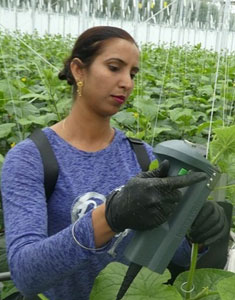Sign up here to subscribe to the Grower2grower Ezine. Every two weeks you will receive new articles, specific to the protected cropping industry, informing you of industry news and events straight to your inbox.
Jan 2022
Russet Mite

Perfect conditions
Several growers I visit are able to grow for long periods with Integrated Pest Management (IPM) and without invasive chemical intervention. Unfortunately, there are still certain periods of the year that luck is required to avoid using chemical intervention.
On a recent visit to one of my customers, that had been successfully using IPM, they raised concern about a brown stain they had noticed appearing on the stems of their tomato plants. One look and I knew it was Tomato russet mite.
When I first started growing, in the 1990’s, I was using IPM as a tool to combat whitefly, all was going very well until I noticed a brown stain on the stem. At that time, I was totally unaware what it was, let alone the terrible damage it could do if not fixed. Very quickly, and with some advice, I learnt it was Tomato russet mite. I tried spot spraying hot areas with a chemical to avoid killing all of my beneficials – unfortunately spot spraying did not control its spread. The damage it caused to the plant was severe. Reluctantly I had to revert to spraying the entire crop using some friendly chemicals. However, they still had a negative reaction on the IPM programme. I found out how extremely difficult this mite was to eliminate.

The recent weather has been exceptionally hot. I used to find when the weather heated up that Tomato russet mite could become an issue. Reluctantly, I advised the grower to protect his crop the best he could, but it would mean the IPM programme would be compromised. A tough decision but without other tools in the tool box it is the best advice for now.
Note: Psyllids may become an issue in the coming weeks – keep an eye out for the sugary secretion they deposit on the leaf.
Article written and compiled by Stefan Vogrincic
All Article’s checked and edited by Marie Vogrincic
I appreciate your comments. Please feel free to comment on the grower2grower Facebook page:
https://www.facebook.com/StefanGrower2grower/
See below extracts from the Koppert Website regarding Tomato russet mite:
The tomato russet mite (Aculops lycopersici, also referred to as Vasates lycopersici, Vasates destructor and Phyllocoptes destructor in older publications) belongs to the family Eriophyidae. It does not produce galls but lives freely (vagrant) on tomato plants. Aculops lycopersici was detected for the first time in Australia and is a pest in tomatoes in all areas where they are grown. Other members of the plant family Solanaceae may be affected to a lesser extent.
All life stages of the tomato russet mite are extremely small and difficult to observe. They are elongated (torpedo-shaped), soft and segmented. The body appears to be divided into two parts: the head with the mouthparts, and the rest of the body. All mobile stages have only two pairs of legs, whereas other mite groups have four pairs.
Eggs are roughly 0.05 mm in diameter and are laid on the underside of leaves, on leaf petioles, and on stems on the lower portion of plants. When newly laid they are creamy white but turn to a patchy yellow as they age. The mites have two nymphal stages: sometimes they are also called larva (1st stage) and nymph (2nd stage). The first nymphal stage is a transparent white colour and about 0.1 mm long. They usually develop to the 2nd stage within a day. All life stages look very similar. The adults develop after about two or three days. They are cream to orange-yellow in colour, wedge-shaped and very small (roughly 0.17 mm in length), with males being slightly smaller than the females.
Damage is caused by the mites sucking out the contents of plant cells. Affected leaves are slightly curled and acquire a silvery sheen on the underside. Later they become brown and brittle. Badly affected tomato leaves and stems lose their trichomes (leaf hairs). Affected stems turn a rusty brown colour, and in serious cases they may snap. The fruit can also be affected, and when this happens in tomatoes, the skin becomes coarse and turns reddish brown and the fruit itself is sometimes deformed. Considerable damage can occur, especially at high temperatures when population growth is most rapid and affected leaves dry out quickly. The damage is first seen on the lower part of the plant and moves upwards as the mites ascend.
Source: https://www.koppert.ca/challenges/spider-mites-and-other-mites/tomato-russet-mite/
CLASSIFIED
Photo
Gallery
Subscribe to our E-Zine
More
From This Category

Greenhouse Production in the Future – Mike Nichols

Industry spearheads adoption of labour-saving tech with $52M boost (Australia)

a1 Apple Website Launched to Complement Brand Refresh
(Video of session now available) Excellent online webinar hosted by De Ruiter/Bayer Australia

Merry Christmas and Happy New Year 2024




































